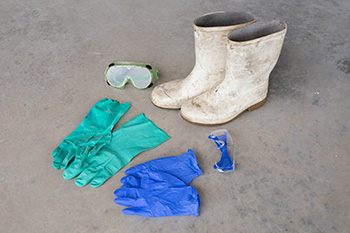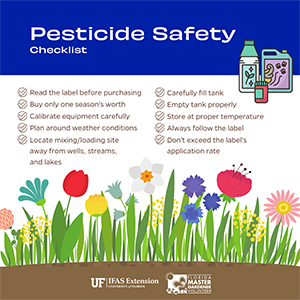Pesticide Safety: Application and Disposal
Protect Yourself
The proper protective equipment must be used any time that pesticides will be applied. Always read the label to see what minimum personal protective equipment is required when using a particular pesticide. Common personal protective equipment includes:

Pesticide application protective equipment. UF/IFAS.
- Gloves (labels may specify that gloves be waterproof or chemical resistant, which are two distinct terms offering different levels of protection)
- Safety glasses, goggles, or face shield
- Particle mask or respirator
- Full-coverage clothing (labels may specify that applicators wear shoes and socks, a long-sleeved shirt and pants, or even coveralls)
Immediately after applying pesticides, you should take a shower or a bath and change into fresh clothing. The clothes you wore while applying pesticides should be washed separate from regular laundry. If your clothes are really covered with pesticides, you should probably just discard them; no amount of washing can entirely remove the pesticides.
If any symptoms of exposure arise—dizziness, headache, or nausea—seek medical treatment immediately and bring the pesticide label with you.
Application
It is very important to read and follow the application guidelines on a pesticide label. Some homeowners may think that applying more than the recommended amount of a pesticide or applying a pesticide more frequently will improve pest control, but more is not better. In fact, it’s unsafe and illegal. Applying more than the recommended amount of pesticide can damage your landscape plants and beneficial organisms, cause environmental harm, and excess pesticides can end up in our water supply. Not to mention that it's a waste of money.
On the other hand, applying too little pesticide can also cause problems, such as failure to control the pest population. Therefore, you'll need to spend a little time figuring out the amount of area that you wish to treat with pesticide and also how much pesticide you’ll need to complete the job.
If mixing a concentrated pesticide with water is necessary, the label will often list the percentage of desired concentration that should be achieved. Other concentrated products will list their rates as an amount to apply per unit area. Lawn care products commonly list this amount in terms of 1,000 square feet. If this is the case, it is important to have accurate dimensions of the area to be treated so that the proper amount may be mixed. These types of products are commonly applied with hand-held sprayers such as hose-end or hand-pump applicators. Many of the product labels for granular products include a table with a listing of settings that are specific for popular granular lawn spreaders.
Practically all pesticide labels for homeowner products will have very clear and simple dilution directions. Other pesticides may include instructions that specify a dilution rate and that say, “Spray thoroughly, covering both sides of leaves, stems, and branches,” or, “Thorough uniform coverage is necessary.” In these cases, you can apply the pesticide without needing to know the total volume of pesticide that will be applied in the treatment area.
Safe Disposal
Do you have unused pesticides sitting in your garage or garden shed? Even those of us who practice Integrated Pest Management (IPM) have a few chemicals lying around.
When it's time to use it or lose it, read the label! Read our article Pesticide and Fertilizer Disposal for more information on this important topic.
Source
F. Fishel, Homeowner's Guide to Pesticide Safety (PI051), Agronomy Department (rev. 08/2012).


